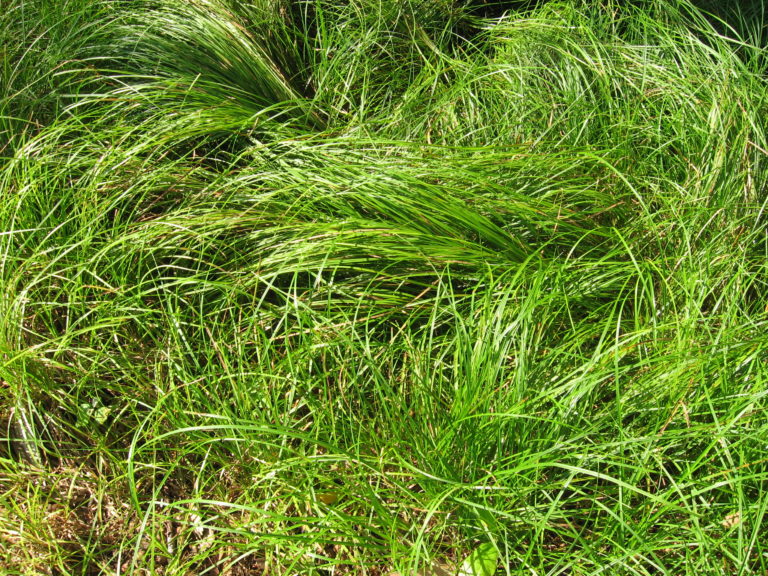Carex pensylvanica, or Oak Sedge (or Pennsylvania Sedge) is found in dry woods mostly in Northeastern U.S. In North Carolina it occurs naturally in the mountain counties. This is one of the more popular sedges for gardeners and landscapers in our area because of its versatility. Plants are about 8 inches high (less than 12 inches when flowering), leaves are grass-like and delicate, and the habit is arching and graceful. Like many other sedges it grows well in part shade to full shade, but it stands out because it tolerates more sun (if moist) and spreads by rhizomes as well as by seed. It thrives as a living mulch under trees, shrubs and taller perennials. Pennsylvania Sedge can aslo be used as an alternative “No Mow” lawn to great effect, but it does not tolerate foot traffic. It prefers medium to dry soils, but because it can withstand wet conditions also, it is a good choice for rain gardens. It provides cover for small mammals and ground loving birds, and since it flowers and fruits early in the season before the warm season grasses, it is an early food source for a range of animals.
NURSERY HOURS
Wednesday: 10-4 Thursday: 10-6 Friday-Saturday: 10-4 Sunday: 12-4
Carex pensylvanica

Key Info
Scientific Name: Carex pensylvanica Lam.
Common Names: Oak Sedge, Pennsylvania Sedge
Family Names: Cyperaceae (Sedge Family)
Leaf Retention: Evergreen
Bloom Times: May
Flower Color: Inconspicuous
Special Characteristics: Tolerates shade, Tolerates drought, Evergreen, Slow growing, Tolerates wet conditions, Good wildlife cover, Rhizomatous, Reported to be deer resistant.
Additional Info
Habit: Grows in clumps about 8" tall (less than 12 inches tall with flowering stalks) delicate, arching leaves, fibrous roots, spreading by rhizomes as well as by seed.
Height: 8-10"
Spread: 8-10"
Soil Conditions: prefers medium to dry, light textured, acid soil but can tolerate both drought and wet conditions
Leaves: grass-like leaves 1/8" up to 12" long
Flowers (or reproductive structures: Monoecious (male and female flowers on the same plant). The flowering culms, triangular stems, bear a male or staminate spike at the apex, and 1 to 3 female spikes just below, in position to receive pollen. The staminate spike has showy, creamy yellow stamens, pistillate spikes have long, white, thread-like styles.
Fruit: Fruit develops in mid to late spring, the pistillate spikes forming clusters of seeds (achenes), each wrapped in a casing. The empty staminate scales persist after fruit has dropped off. Pistillate spikes each contain 4 to 12 fruits.
Natural Distribution: Dry forests, woodland edges and savannas
USDA Hardiness Zone: 3 to 8
Pollination: Wind
Wildlife Connections: Deer resistant; cover for small mammals and ground loving birds; seeds are food for birds and small mammals.
Propagation: By division of mature plants in spring.
